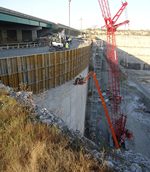 The Metropolitan Water Reclamation District of Greater Chicago (MWRD) has reached an agreement that will allow space for an additional 4.5 billion gal. of storage capacity for combined sewage and stormwater, reducing flooding in the south suburbs.
The Metropolitan Water Reclamation District of Greater Chicago (MWRD) has reached an agreement that will allow space for an additional 4.5 billion gal. of storage capacity for combined sewage and stormwater, reducing flooding in the south suburbs.
The MWRD was granted an extension to its easement with Hanson Material Service Corp., which is mining the quarry. The $750,000 annual investment will allow the MWRD to continue to use the Thornton Transitional Reservoir for storage of floodwater from Thorn Creek through 2020. Terms of the deal were approved by the MWRD Board of Commissioners on April 23.
“This is a great opportunity for the district and the south suburbs,” said MWRD President Mariyana Spyropoulos. “It will allow us to prevent future flooding by adding capacity and will also help us determine how much storage will be needed when the composite reservoir is completed this year.”
The Transitional Reservoir, completed in 2003, is used strictly for stormwater from the Thorn Creek drainage basin. It is located in the lower west lobe of the Thornton Quarry across the interstate highway from the Thornton Composite Reservoir.
When it is complete this summer, the Thornton Composite Reservoir will hold up to 7.9 billion gal. of combined sewage and stormwater from 14 communities throughout the south suburbs and South Side of Chicago, making it one of the largest reservoirs of its kind in the world. Having the Transitional Reservoir available will allow MWRD engineers more time to evaluate the storage capacity in the Composite Reservoir given the increasing amount of heavy rainstorms in recent years.
The Thornton Quarry is part of MWRD’s Tunnel and Reservoir Plan (TARP), also known as “Deep Tunnel,” providing a series of deep, large diameter tunnels and vast reservoirs aimed to reduce flooding and improve water quality in area rivers and streams.
The Thornton Reservoir is set to come online at the same time as disinfection facilities at the MWRD’s Calumet Water Reclamation Plant in Chicago. Working in tandem, the combination will maximize water quality while minimizing flooding.

